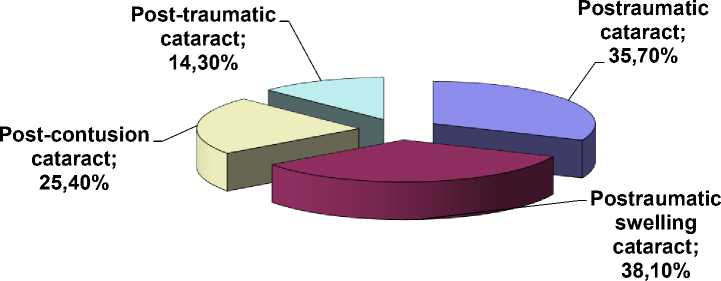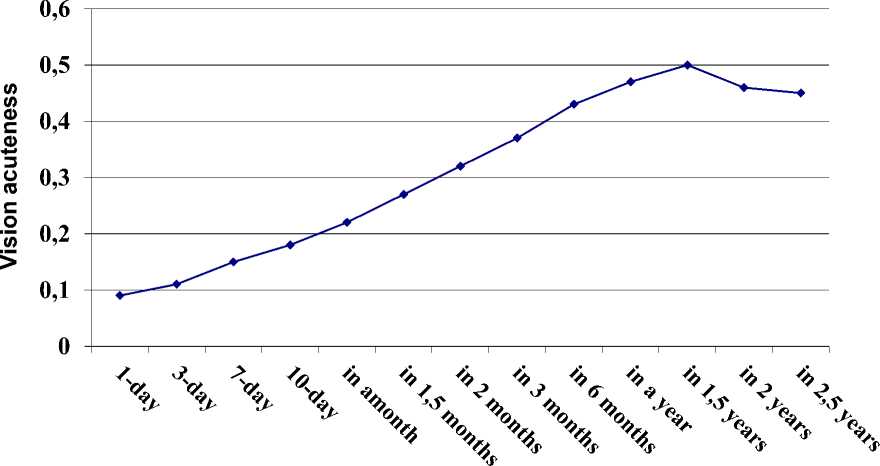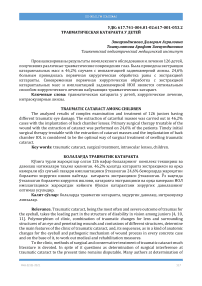Traumatic cataract among children
Автор: Zakirhodzhaeva Diloram Asralovna, Toshpulatova Arafat Zievutdinovna
Журнал: Re-health journal.
Рубрика: Офтальмология
Статья в выпуске: 2 (10), 2021 года.
Бесплатный доступ
The analyzed results of complex examination and treatment of 126 juniors having different traumatic eye damage. The extraction of catarrhal masses was carried out in 46,2% cases with the implantation of back chamber lenses. Primary surgical therapy treatable of the wound with the extraction of cataract was performed on 24,6% of the patients. Timely initial surgical therapy treatable with the extraction of cataract masses and the implantation of back chamber IOL is considered to be the optimal way of surgical treatment of swelling traumatic cataract.
Traumatic cataract, surgical treatment, intraocular lenses, children
Короткий адрес: https://sciup.org/14125621
IDR: 14125621
Текст научной статьи Traumatic cataract among children
БОЛАЛАРДА ТРАВМАТИК КАТАРАКТА
Кўзига турли жароҳатлар олган 126 нафар болаларнинг комплекс текшириш ва даволаш натижалари таҳлил қилинган. 46,2% ҳолатда катаракта экстракцияси ва орқа камерали кўз сунъий гавҳари имплантацияси ўтказилган 24,6% беморларда жароҳатни бирламчи хирургик ишлов пайтида катаракта экстракцияси ўтказилган. Ўз вақтида ўтказилган бирламчи хирургик ишлови, катаракта экстракцияси ва орқа камерали ИОЛ имплантацияси жароҳатдан кейинги бўккан катарактани хирургик даволашнинг оптимал усулидир.
Калит сўзлар: болаларда травматик катаракта, хирургик даволаш, интраокуляр линзалар.
Relevance. Traumatic cataract, being the most often and severe outcome of traumas for the eyeball, takes the leading part in the structure of disability in vision among juniors [4, 10, 11]. Polymorphism of clinic, combination of traumatic changes for lens and surrounding structures of an eye and penetrating wounds and contusions of different structures, determine the main features of the clinic of traumatic cataract, and, its sequences, as in a kind of anatomic changes for the eyeball and pathogenic mechanism of wound process in every concrete case and on the base of it, to work out medical and rehabilitation measures.
To the clinic, methods of surgical and conservative treatment of traumatic cataract much literature is devoted. In spite of it questions as determination of surgical interference at traumatic cataract to the present time remains disputable. Many authors at determination of terms for surgical treatment traumatic cataract, even swelling, consider, that it should be done in 4-12 months after wounds after liquidation of all inflammatory displays [1, 2, 8, 9]. So, the medical and rehabilitation measures are planned to perform differently at penetrating wounds and contusion of an eye. At penetrating wound they sum from the primary microsurgical treatment with simultaneous solving the question on possibility extraction of traumatic cataract and performing implantation of intraocular lens (IOL) or necessity of postponement extraction of cataract after taking conservative treatment [3, 5].
The aim of present study was results analysis of clinical examination of children with traumatic cataracts during the process of surgical treatment.
Material and methods. The materials for the study were the results of complex examination and treatment of 126 children with different traumatic damages of eyes. The research was carried out in ophthalmological unit of clinic at TashPMI. Among the examined patients the boys were 96, that was 76,2%, and girls were 30 (23,8%). All patients with traumatic damages of the eyes took treatment in hospital. Average hospital days of the patients were 8,5 ± 0,30 bed-days. Among the examined prevailed the children from 3 to 14 years old, those who were 96,8% from the general number of traumas. But the average age of the examined children was 8,3 ± 0,31 years. All patients were performed standard ophthalmological studies: visometry, tonometry, biomicroscopy, ophthalmoscopy, and, also special: X-ray study of orbit, AB scanning of the eyes, ultrasound biomicroscopy. Evaluation of treatment efficacy was taken by the following criteria: increase of vision acuteness, arrest of inflammation, resorption of inflammatory exudation and fibrinous covering, arrest of hemorrhagic foci, and, also, reduction of the treatment terms.
Results and their discussion. Our studies showed that two eyes are undergone to trauma (right eye is 65 (51,6%), left one is 61 (48,4%). It was also determined the contusion cataracts less (28,6%), in comparison with traumatic cataracts after penetrating wound of eye (71,4%).
Distribution of the patients by the remoteness of taken trauma to the time of addressing to clinic showed, that the main mass (73,8%) victims address during 1 month, though 12,3% victims come to clinic for 3 years after trauma, that, naturally, is negative reflected on the results of taken medical measures.
The taken examination to the moment of admission of patients to the clinic showed that more often juniors come with post – traumatic swelling cataract (pict.1).

Picture 1. Distribution of the patients by the diagnosis (%)
Taking into account of remoteness of occurrence of the trauma, together with the main disease we observed and complications (table.1).
Table 1
Complications from the eyes’ side, accompanying traumatic, cataract
|
Complications of penetrating wound |
Number of patients |
|
|
abs |
% |
|
|
Obscuration squint |
41 |
32,5 |
|
Secondary cataract |
4 |
3,2 |
|
Secondary glaucoma |
4 |
6,3 |
|
Foreign bodies |
30 |
23,8 |
|
Hemophthalm |
7 |
5,6 |
|
Phatogenic uveitis |
8 |
6,3 |
|
Endophthalmitis |
3 |
2,4 |
|
Post-traumatic calcificated cataract |
1 |
0,8 |
|
Post – traumatic semidissapeare membranous cataract |
11 |
8,7 |
During our studies it was determined, that in 12 patients (9,5%) was post – traumatic aphacia, in 58 (46%) was lens opacity of different degree, in 10 (7,9%) among them was swelling cataract.
All patients were taken surgical interference. Distribution of patients by the way of performing operation was presented in table 2.
Table 2
Distribution of patients by the way of interference
|
Number of patients |
Implantation of IOL |
Intracapsular implantation IOL |
Extraction of swelling cataract |
PSO + extraction cataract |
Extraction of cataractal masses |
|
Abs |
62 |
9 |
25 |
31 |
71 |
|
% |
46,2 |
7,1 |
19,8 |
24,6 |
56,3 |
According to table 2 data mainly the extraction of cataract masses were taken, by that in 46,3% cases with implantation of camera posterior bulbi lens, 24,6% patients were taken primary surgical treatment with extraction of cataract. In 9 patients (7,1%) extraction of cataract was performed intracapsularly. Tactic elements of taken surgical interferences are presented in table 3.
Table 3
Distribution of patients by the performed elements of surgical interferences
|
Complications of penetrating wound |
Number of patients |
|
|
abs |
% |
|
|
Sinechiatomy |
64 |
50,8 |
|
Iridectomy |
90 |
71,4 |
|
Vitrectomy |
36 |
28,6 |
|
Iridoplastics |
14 |
11,1 |
|
Extraction of calcificaled cataract |
6 |
4,8 |
|
Capsulotomy |
4 |
11,1 |
|
Taking off corneal sutures |
5 |
4,0 |
|
Removing foreign bodies |
7 |
5,6 |
|
Intravitreous introduction of antibiotic |
3 |
2,4 |
|
Reconstruction of frontal part |
27 |
21,4 |
|
Use Hemase |
30 |
23,8 |
As the table witnesses, the main mass of patients (50,8%) were performed sinechiotomy, in 28,6% cases was frontal vitrectomy, in 11,1% cases was iridoplastics. In many part of contingent (71,4%) with the aim of prevention secondary glaucoma iridectomy was performed. At expressed posttraumatic damages with disorder of topographic indices in 21,4% patients reconstruction of frontal eye part was performed. In 5,6% cases intraoperatively the foreign body was found, that was removed during operation.
Results of visometric studies after performing operation were presented in diagram 2, that witness on acuteness of vision was gradually restored from 0,09 to 0,22 by the end of the first month after operation. In 6 months after operation this index was 0,43 ± 0,027, in a year it was 0,47 ± 0,019 and during the next 2,5 years the follow – up of observations were on the same level.

Term of observation
Pict. 2. Dynamics of vision acuteness in patients after extraction of traumatic cataract
Thus, our studies prove, that timely adequate surgical treatment, allows in considerable level to restore functional state of damaged eye.
Conclusions
-
1. Occurence of penetrating wounds for eyeball with the damage of lens in juniors is considerably higher (71,4%) than contusions (28,6%).
-
2. Among the forms of lens damage at traumas of eyeballs swelling cataract prevails (38,1%), that is accompanied by fast developing obscuration squint (32,5%), secondary glaucoma (6,3%) and pathogenic uveitis (6,3%).
-
3. Timely primary surgical treatment with extraction of cataractal masses and implantation of camera posterior bulbi lens (IOL) I optimal way of surgical treatment for swelling traumatic cataracts.
-
4. Restoration of functional state of eyes after surgical treatment of traumatic cataract takes place during 1 year, that demands long and regular dispensary observation after given contingent of children at ophthalmologist.
Список литературы Traumatic cataract among children
- Аkshey Khera IOL implantation in patients withcataract of traumaticgenesis // New ophthalmology. - Тashkent. -january-april 2006.-Т.1.№1.-p.5-8.
- Bobrova N.F. Traumas of eyes in children. - M. "Medicine". - 2003. - p.171.
- Zakirhodjaev R.A. Features of surgical treatment of congenital cataracts with the implantation of an intraocular lens and thereabilitationof childrenwith artifakia. Referens. Diss… c.м.s.-Т.-2009.-19с.
- Zaydullin I.S., Aznabaev R.A. To the tactics of surgical treatment of postuveal being overgrown pupil in children // New in ophthalmology. - M. 2004 w4 p. 26-27.
- Zakirhodjaeva D.A. The resuits of a comprehensive examinationof children with penetrating wounds of the lens// Medical association Bulletin.-T,2013.p 39-43.


